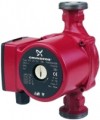Max. flow
The maximum flow of a pump is the amount of liquid it can pump in a certain amount of time.
Features of choosing the optimal performance option depend primarily on the purpose of the pump (see above). For example, for DHW recirculation models, the pump performance should not exceed the performance of the water heater. If the water heater is capable of delivering 10 litres per minute to the DHW circuit, then the maximum pump performance will be 10*60=600 L/h. The basic formula for calculating the performance of a heating system takes into account the power of the heater and the temperature difference at the inlet and outlet, and for the cold water system — the number of points of water intake. More detailed information about the calculations for each application can be found in special sources, and it is better to entrust the calculations themselves to professionals.
Max. head
The head can be described as the maximum height to which a pump can lift liquid through a vertical pipe without bending or branching. This parameter is directly related to the pressure that the pump produces: 10 m of head approximately corresponds to a pressure of 1 bar (do not confuse this parameter with operating pressure — see more about it below).
The head is one of the key specs for most circulation pumps. Traditionally, it is calculated based on the difference in height between the location of the pump and the highest point of the system; however, this principle is relevant only for units that
boost the pressure of cold water(see "Suitable for"). Circulation pumps for heating and DHW work with closed circuits, and the optimal pressure depends on the total hydraulic resistance of the system. Detailed calculation formulas for the first and second cases can be found in special sources.
Minimum fluid temperature
The lowest fluid temperature at which the pump is capable of operating normally.
Almost all pumps can normally transfer cool water, regardless of the purpose (see above); therefore, for normal household use, this parameter is not critical and for some models, it may not be indicated at all. But if you need the ability to work with liquids with temperatures below 15 °C, you should pay close attention to the minimum temperature. Some models that can be used with antifreeze normally tolerate even temperatures below zero.
Max. power consumption
The electrical power consumed by the pump during normal operation and maximum performance.
This indicator directly depends on performance — after all, for pumping large volumes of water, an appropriate amount of energy is needed. And the power depends on two main parameters — electricity consumption and the load on the power grid, which determines the connection rules. For example, pumps with a power of more than 5 kW cannot be connected to ordinary household sockets; more detailed rules can be found in special sources.
Country of brand origin
In this case, the country of origin refers to the country from which the product brand originates. A brand, in turn, is a general designation by which the products of a particular company are known in the market. The country of its origin does not always coincide with the actual place of production of the product: to reduce the cost of production, many modern companies transfer it to other countries. It is quite normal for products, for example, of an American or German brand, to be made in Taiwan or Turkey. Contrary to popular belief, this in itself does not lead to a decrease in the quality of the goods — it all depends on how carefully the brand owner controls the production. And many companies, especially large and famous ones, monitor the quality very zealously — after all, their reputation depends on it.
Noise level
The noise level produced by the pump during normal operation. For comparison, 50 decibels roughly corresponds to the noise in an office room, 60 dB to an average TV volume, 70 dB to a truck at a distance of about 8 m, 80 dB to traffic noise, and 90 dB to a loud scream. The lower the noise level, the more comfortable the use of the pump and the closer it can be placed to people. This parameter is especially important for models installed in residential premises.
Port-to-port length
The installation length is the distance between the inlet and outlet of the pump, in other words, the length of the segment occupied by the pump in the circuit. This parameter allows you to estimate the amount of space required for the unit, and determine the length of the pipe section that needs to be cut.

